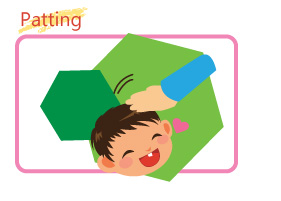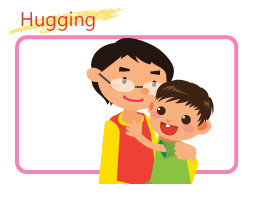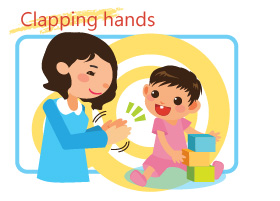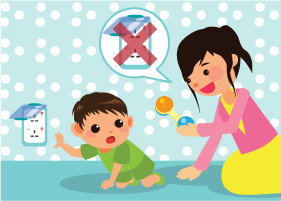Video
Start disciplining your toddler in a positive way – English
Heading: Start disciplining your toddler in a positive way
Narrator: With the advancement in the physical, intellectual and language development of the one-year-old, you need to show your child more about the world. Tell him what he can and cannot do. Starting positive discipline with your toddler now helps him to grow up into a cooperative child.
Scene: The parents encourage their boy to tidy up toys on the floor.
Sub-heading: 1. Encourage desirable behaviour
Scene: When the boy picks up the TV remote control, daddy waves his hand to indicate no and takes it away.
Narrator: Encourage your child's desirable behaviour so that she will be more likely to do it again.
Scene: Parents clap hands and give a thumb-up when girl puts toy into a basket. Girl also claps hands happily.
Sub-heading: 2. Set simple rules
Daddy: Wash your hands before dinner.
Narrator: You can set 3 to 4 simple rules for your child.
Scene: Daddy takes girl to sit at the dinner table after washing hands and says, “Sit down and eat.” He then sit down together with mum and girl.
Narrator: Don't forget to set a good example for your child.
Scene: Daddy praises girl when she eats with a spoon.
Narrator: Set limits and boundaries such as keeping your child away from areas of potential danger.
Scene: Mummy is working in the kitchen with a shut child-proof gate. Girl approaches mummy and mummy tells her to stay in the dining room to play.
Sub-heading: 3. Assertive discipline
Narrator: Give simple short and clear instructions for the child to follow.
Scene: Daddy takes child to the high chair at the dinner table.
Daddy: Stay in your seat.
Scene: Girl points to the other side.
Daddy: Not now. Stay in your seat.
Narrator: If your child follows, praise her such as touching her head and say “Well done”.
Sub-heading: 4. Stop misbehaviour immediately
Narrator: You have to stop your child's misbehaviour especially dangerous acts immediately. Then redirect her attention to other interesting activities.
Scene: Daddy stops child immediately when she touches a socket. He takes her away and gives her a toy to play with instead. He also places a socket cover on it.
Narrator: Remember, assertive discipline needs everyone in the family to be firm, consistent and follow through in managing your child's behaviour.
Key Points of Positive Discipline
Positive discipline is using constructive and non-hurtful ways to develop desirable behaviours in your child. When parents discipline your child in a positive way based on her unique characteristics, you can support her development of self-control, nurture good character and abilities, while you will also get along better.
How can parents do that? Read on about the following keys:
To make the above points effective, parents need to implement them persistently and consistently.
Encourage and praise good behaviour
Apart from correcting undesirable behaviour, you need to praise and encourage your child when she behaves. For instance, you can praise your child “you stay in the seat when you eat, good girl!” or “you greet the guard on seeing him, well done!”. When you praise your child, try to concretely describe your child's desirable behaviour. Through such praises, you can teach her what behaviours are appropriate, encourage desirable behavior while promoting her self-image. Your verbal praises can also be coupled with the following actions:






Set simple rules
Simple rules can help your child understand the expectations and limits on their behaviour, making it easier for him to follow
- Set simple ground rules for your child including places that should be out of reach for him (e.g. the kitchen).
- Use positive wordings, e.g. “finish your meal before you leave the seat” is easier to follow than “don't leave without finishing your meal”.
- Set 3 to 4 rules that match with the age and abilities of your child.
- All caregivers should consistently follow through the rules set.
Here are some examples of rules that may be set for children of this stage:
- Stay in the living room when mummy is busy in the kitchen
- Always hold an adult's hand when going out
- Stay in the sitting room when mummy is busy in the kitchen
- Only adults can turn on the electrical appliances (including TV)
- Wash hands before eating
- Place the shoes on the shelf after taking them off……… etc.
Guide Your Child to Cooperate
Why don't children cooperate?
With the development of mobility and cognitive abilities, children at this stage are curious about the things around them, and may behave inappropriately when they explore, such as throwing things, and touching or running around in unfamiliar environments. At the same time, because of their limitations in language and self-control, children may not be able to comply immediately when parents ask them to cooperate, and may even lose temper when upset.
Prevent undesirable behaviour with distraction
In some cases, children are more likely to behave inappropriately, for instances, when they have nothing to do or get impatient when told to wait, or when they are so engaged in their play and have difficulty following instructions from parents. In such cases, parents may guide the child to cooperate by using distractions. Here are some common ways for parents to distract:
- Suggest your child to observe interesting things around you, such as pointing out some uncommon cars while waiting for a bus.
- Ask her to do something else that is appropriate, e.g. when she is bored and starts messing around at home, give her a toy to play with
- Make what you are doing fun, such as asking her to help find her favorite fruits and vegetables when you are shopping at the supermarket
- Talking, singing or playing with your child
- Bring her out of the scene, for example, if your family is dining out, take her out for a walk after she has done eating
Handling non-compliance
When your child does not follow instructions, stay calm and firmly ask her to stop the inappropriate behaviour or repeat your instruction. If your child is showing strong emotions, you may first respond to your child's feelings with “emotion coaching” before distracting or guiding her to cooperate. For example, when your child is engaged in play and refuses to go to bed, parents can first briefly describe her current status and feelings: “You're having so much fun with your toys! You want to keep playing! …… (pause and repeat your instruction in a playful way) Time for the toys to go home, and time for you to go to bed.” If your child is not too upset but still reluctant, you can distract him by saying, “let's pick a story to read in bed together!”. If your child is resistant or even cries, you may describe your child's emotions to help her calm down as you gently and calmly carry her to bed.
To learn more about responding positively to children's emotions, check out the video and pamphlet on “emotion coaching”.
Correct dangerous acts immediately
You have to stop any dangerous acts of your child immediately and teach him before redirecting his attention to some other interesting and safe activities, e.g.,
- “The socket is dangerous. Don't touch. Come and play with mommy”.
- “You may fall and hurt yourself if you climb up. Come down and play ball with me”.


